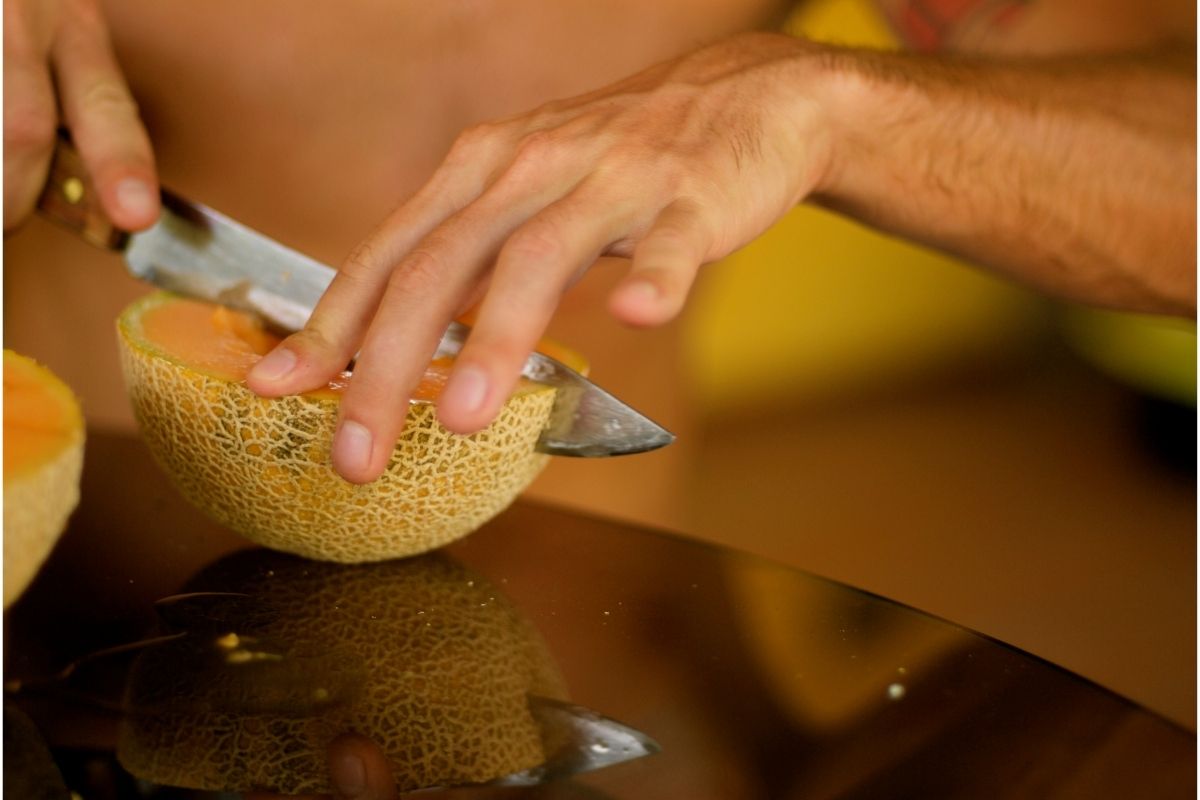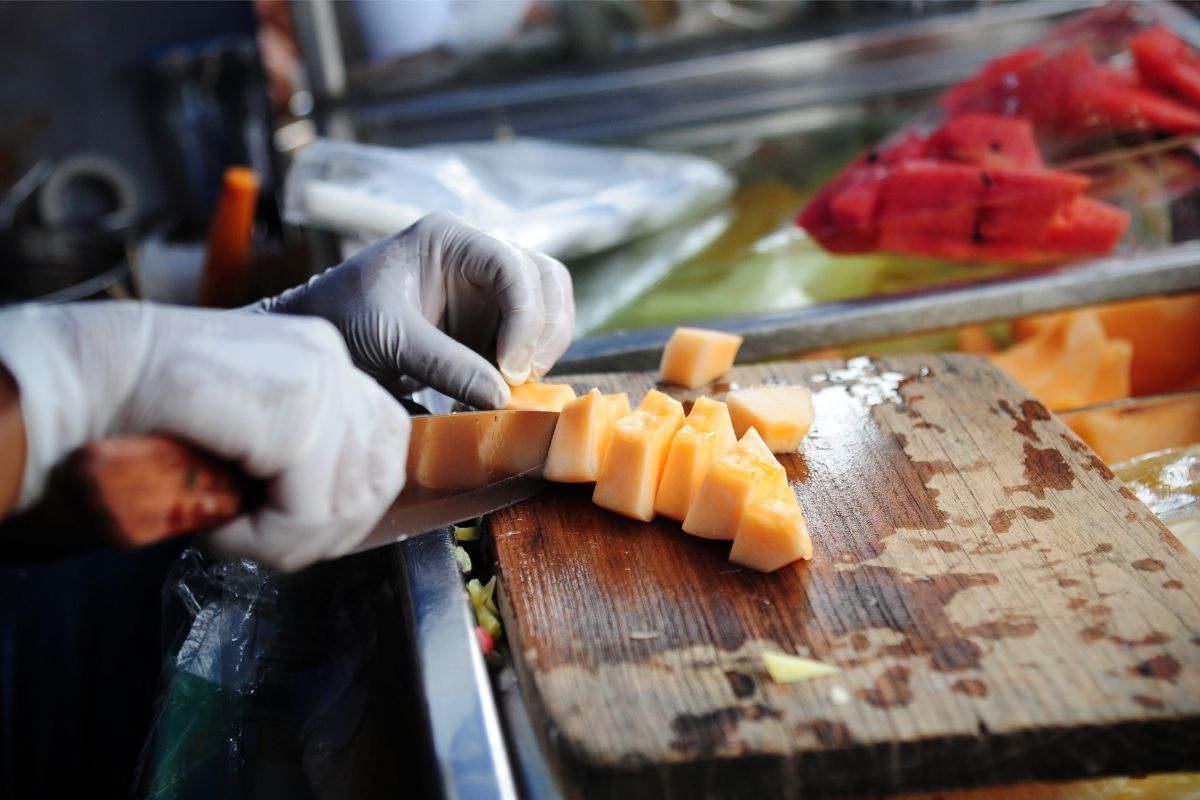Have you ever wondered how to cut a melon, what is the best way to cut a cantaloupe, or how to cut a cantaloupe fancy? There are many ways to cut a cantaloupe, but have you ever wondered which is the best way? We’re here to help. We will show you three different ways to cut their melons. You can decide for yourself which method works best for your needs!
What Is a Cantaloupe?
Cantaloupe is a delicious orange summer fruit descended from watermelon and honeydew melon. Pumpkins, squashes, and gourds are all in the same plant family as cucumbers. The most frequent semi-sweet cantaloupe in the United States is Cucumis melo reticulatus, a muskmelon cultivar.
The scientific name is derived from “reticulated,” which refers to the cantaloupe’s rough, webbed outer skin. Cantaloupes have been grown for thousands of years. However, the majority of experts agree that it originated in Persia. Christopher Columbus brought the fruit to the New World on his second expedition in the late 1400s.

How to Pick a Good Cantaloupe
You’ll need a quality, ripe cantaloupe to get started. You should avoid external or spongy places. When you push your finger on the outside of ripe cantaloupe, it will have a slight give to it. Peeling and cutting cantaloupe becomes more straightforward as a result.
You frequently have to settle for a not-yet-ripe cantaloupe, which you leave on my kitchen counter for a few days until it feels just right. Cantaloupe that is ripe tastes better and is easier to peel and slice.
Also, rinse your cantaloupe thoroughly to help eliminate any dirt or pesticide residue. If desired, a fruit and vegetable wash might be utilized. And the best knife for the job is a good, sharp chef’s knife.
Removing the Cantaloupe Rind and Seeds
Cantaloupe is a delicious, nutritious fruit. It has a deliciously sweet and distinctive flavor that brings to mind the taste of summer. However, if you buy your cantaloupe at the store or simply want to use what you already have at home, how do you know how to cut it? The rind and seeds are inedible, so how do you go about removing the excess material?
Depending on how you want to serve it, you can cut a cantaloupe in various ways. For example, you can serve thin or thick wedges, peeled slices, melon balls, or cut-out forms by following a few simple procedures.
No matter how you want to serve it, the initial few stages of chopping a cantaloupe are the same.
Cut the Cantaloupe in Half and Remove the Ends
Turn the cantaloupe on its side, stem end facing one direction (not the top or bottom). Cut about 1/4 to 1/2 inches (0.63 to 1.27 centimeters) from the stem end and the opposite end of the cantaloupe with a sharp chef’s knife or utility knife. Because the portions you’ve chopped off are primarily rind and peel, you can toss them out.
Halve the Cantaloupe
You can stand the cantaloupe up on your cutting board with the ends cut off to make it easier to cut. You may now divide it into two halves by cutting it down the middle. These halves are the starting point for five cantaloupe cuts and serving options.
Remove the Seeds With a Spoon
Cantaloupes feature a mushy, seed-filled center. You can use your hands to scoop out the center or a large spoon to remove it. After removing the seeds, cut cantaloupe into serving sizes of your choice.

What Is the Best Way to Cut Cantaloupe in Slices?
Cutting cantaloupe in slices is a quick and easy way to serve the fruit. The following will teach how to cut a melon so that it may be served as individual pieces or left whole depending on how you will eat it.
Steps
- Cut off both ends of the melon as if slicing it in half. The ends are where dirt and other things could have been collected.
- Stand the melon upright on a flat surface, and using a sharp knife, cut down following the contours of the fruit until you reach the center. Be careful! This can be dangerous, so use caution when wielding the knife. Start at one end and slowly work your way around until you reach the other end.
- Cut up or across the melon to make slices however many you want. The more horizontal lines, the larger your piece will be when finished cutting. A good number of cut lines for this are between 5 and 8.
- The cantaloupe is now ready to eat and enjoy! No matter how you sliced it, the cantaloupe should easily separate into slices due to the soft texture of the fruit. Nothing more than a fork or spoon is needed to separate them from each other and dish out the cantaloupe for eating.
- Be mindful of the cantaloupe rind, as it is often covered in a waxy substance, which can be transferred to your cantaloupe slices. If this is an issue, give each piece a quick rinse instead of eating them directly from your hand.
Tips to Have in Mind When Cutting Cantaloupes
The weight and firmness of cantaloupes can vary, so cutting them up before they are too soft or too firm is your best bet.
If you wish to leave the cantaloupe whole after cutting, just cut out both ends and remove the rind with a peeler. The cantaloupe will be easier to handle when whole.
Different cantaloupes can have different textures, so smaller cantaloupe rinds are more challenging to cut through than larger ones. This gives you some leeway on what blade size to use for cutting slices of the cantaloupe. A serrated knife works well with cantaloupe rinds because it is not as sharp as a regular knife.
A cantaloupe slicer is a tool made for removing cantaloupe rinds and cutting cantaloupes into slices simultaneously. This makes the job much easier without cutting the fruit with a dull knife or peeling off cantaloupe rinds with a peeler.
Some cantaloupes are more challenging to cut than others, so having a cantaloupe slicer on hand can be very useful if you have cantaloupes that are almost too mushy or hard to slice by hand.
Cantaloupe cutting into slices makes it easy to grab and eat without messing. There are many ways one can cut cantaloupe into pieces, with or without cantaloupe slicers depending on the cantaloupe texture and size.
Cantaloupes should be left out until they are soft enough to slice for them to be properly sliced. It is possible to slice cantaloupe when it is too firm, but it will need to be cut into thicker slices and may not always separate into individual cantaloupe pieces without help from a fork or spoon.
How to Cut a Melon in Wedges
Melon wedges are frequently served. Melon halves are most often cut on the fruit side up. The easiest method to cut cantaloupe wedges is to place the cantaloupe half, fruit side up, on your cutting board. Cut the cantaloupe lengthwise into halves or quarters. Cut off a small piece of fruit from opposite sides of each quarter to make a stable base.
You can also place the melon with the flat surface face down on your cutting board. Cut lengthwise into halves, quarters, or eighths, depending on what size slices you desire. Turn each piece of melon over and cut off a small wedge-shaped piece from opposite sides of each piece to stabilize the fruit. Cut each piece in half, then cut each half into halves or quarters for wedges.
If it is a honeydew melon, slice lengthwise into halves or quarters. This type of melon may be too soft to pick up and turn over, so you may want to cut it on the serving plate after carving the fruit side. Cut each quarter into halves or thirds to make wedges.
Cutting tip: If you’re cutting a large melon, use a chef’s knife and work on top of a shallow pan to catch juice for easier cleanup.
Begin by making cuts at the ends of each piece to slice out the seeds (you can use these for snacks!)
Then cut the leftover pieces in half again to make eight wedges in total. Again, angling the knife toward the center of the stem end is beneficial.
Repeat with the other half of the peeled and seeded cantaloupe.
Cantaloupe Cutting Into Bite-Sized Cubes
Cutting cantaloupe into bite-sized cubes can often be a difficult task. It takes a steady hand and quick action of the knife to get through the tough rind without tearing or damaging chunks of flesh. However, a simple technique will allow you to cut up the melon in seconds quickly!
This method involves using a serrated knife. While it may seem counter-intuitive to use a jagged edge for cutting up something as smooth as cantaloupe, the rind is much more challenging than you might expect.
Rather than trying to match your motions precisely to the shape of the melon, aim to cut through just one or two threads at a time. Once you have cut through the rind, it will be easy to score the flesh of the melon without cutting too far so that it is already in cubes rather than long strips.
Set the melon half on its flat side once you’ve cut out all of the seeds. Cut it across into 1/2-inch (1.27- centimeter) slices.
Place each slice flat on your work surface and cut lengthwise in half. For easier cutting, place an apple core over the melon at a 45-degree angle to protect your hand.
Now you have two strips of cantaloupe to cut crosswise into 1/2-inch (1.27-centimeter) cubes. And if you’re feeling lucky, try cutting the melon in half and serve it up like a bowl!
Finally, place each cantaloupe slice flat on your work surface again. Cut lengthwise in half.

Cantaloupe Storage Instructions
Once you’ve cut the cantaloupe, be sure to store it properly. Once cut, refrigerate any leftovers within two hours and place them in a covered container with a paper towel to absorb moisture. You can also store leftover sliced cantaloupe by freezing them for future use.
Remember that the cantaloupe rind will help keep it fresh longer, so never cut a piece away from the whole fruit if you can help it.
Ensure you always wash cantaloupe before cutting into it. Cantaloupe has a natural protective skin covered with many tiny brown waxy particles that give the surface of the melon an unpleasant taste and sticky feel. In addition, cantaloupe is an excellent source of vitamin A and beta carotene, which are important antioxidants that can help protect against cancers.
If you’re looking for a way to cut your cantaloupe, three methods will work. The first is the most traditional and involves cutting off both ends of the fruit to stand on its own. Then all you have to do is remove one layer at a time by running a knife lengthwise down the middle until done.
The second method only requires half as many slices because instead of going from top to bottom, this technique goes from side-to-side with each piece being about an inch (2.5 centimeters) thick.
Lastly, if you want some variety in flavors but don’t want any extra work, just use two different knives or peelers– one should be serrated while the other has smooth edges.
So, what is the best way to cut cantaloupe?
The answer is it depends. If you want smaller pieces that are easy to eat, try using a slicing method. If you want larger chunks or cubes for a salad or side dish, go with chopping. And if you’re looking for something in between, use a slicing method.
No matter which way you choose, make sure to clean your knife and cutting board after each cut to prevent bacteria from spreading. Enjoy your sliced melons! Read our article and find out Cantaloupe Companion Plants.
